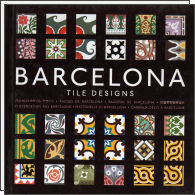 HYDRAULIC TILES HYDRAULIC TILES
Some time in the mid-19th century, a revolutionary technique was discovered to mass-produce tiles without the need for firing to harden them. This new technique involved the use of an hydraulic press and a mould to apply a multi-coloured pattern. The great advantage of this method was that the tiles could be manufactured in one go. This in contrast to the traditional technique to produce ceramic tiles that involved the application of each colour separately and repeated firing – a labour-intensive and time-consuming practice. `Hydraulic tiles' were simply left to dry for some weeks after pressing.
Hydraulic tiles are around 2 cm thick and consist of three layers. The top layer is the decorated surface, about 4 mm thick, made from a mixture of white Portland cement, marble sand and pigments. For each colour, the pigments were blended with water and placed in the corresponding section of a mould. The second layer, the intermediate layer, is about the same thickness as the top layer and made of a mixture of grey Portland cement and sand; its function was to absorb the excess water from the top layer. The third, base layer is approximately 12 mm thick and was made of a mixture of grey Portland cement, regular cement and sand; its porosity made it easy for the tiles to adhere to the floor during installation.
The first reference to a manufacturer of this type of tile is the factory Butsems i Companyia in 1857. At the 1867 Paris Universal Exposition, hydraulic tile. were introduced by the Barcelona-based Garret, Rivet Companyia. Later on, the company Orsola, Sold i Compañía was established, which made this type of tar popular in Barcelona, thanks to its modern machinerL and capacity for mass production. Another prominent manufacturer is Escofet, Fortuny i Companyia, founded in 1886, which was soon noted for its innovative, Art Nouveau-style designs, and whose rapid expansion throughout Spain and Latin America contributed to making this type of flooring so popular. |
 MATTONELLE IDRAULICHE MATTONELLE IDRAULICHE
Verso la metà del XIX secolo, fu scoperta ursa tecnica rivoluzionaria per produrre mattonelle in serie senza dover ricorrere alla cottura necessaria per renderle più dure. Questo nuovo metodo prevedeva l'uso di una pressa idraulica e di uno stampo per applicare un motivo policromo. Il maggior vantaggio era rappresentato dal fatto che le mattonelle potevano essere prodotte con uno sola operazione, al contrario delta tecnica tradizionale che richiedeva un'applicazione diversa per ogni colore e ripetuti processi di cottura, un'elaborazione lungo e faticosa. Bastava lasciar asciugare le mattonelle idrauliche per diverse settimane dopo la pressatura.
Le mattonelle idrauliche hanno uno spessore di circa 2 cm e sono composte da tre strati. Il primo, di circa 4 mm di spessore, costituisce la superficie decorata ed è composto da uno miscela di cemento Portland bianco, polvere di marmo e coloranti. Per ogni colore si preparava un impasto di coloranti e acqua da collocare nel settore corrispondente delllo stampo. Il secondo strato, quello intermedio, di spessore simile al primo, era composto da un impasto di cemento Portland grigio e sabbia; serviva ad assorbire l'acqua in eccesso dello strato nobile. Il terzo e ultimo strato, di circa 12 mm, era composto da uno miscela di cemento Portland grigio, cemento comune e sabbia. La sua porosità facilitava l'aderenza al suolo durante la collocazione.
Al 1857 risale il prima riferimento a un produttore di questo tipo di mattonelle, la fabbrica Butsems i Camponyio, mentre fu la ditto barcellonese Garret, Rivet i Companyio a presentarle presso l'Esposizione Universale di Parigi del 1867. Più tardi, nacque la ditta Orsola, Solà y Compañia che, grazie alle sue moderne attrezzature e alla grande capacità di produzione, diffuse l'uso di queste piastrelle a Barcellona. Non possiamo dimenticare poi la Escofet, Fortuny i Componyio, fondata nel 1886, che si fece subito notare per i suoi innovatori disegni art nouveau, espandendosi sia in Spagna che in America Latina e contribuendo alla popolarizzazione di questo tipo di pavimentazione.
[..]
|


BARCELONA TILE DESIGNS
editore PEPIN
edizione 2006
pagine 208
formato 15x15
hardcover
tempo medio evasione ordine
5 giorni
17.50 €
9.00 €
ISBN : 90-5768-073-4
EAN : 9789057680731
|
|